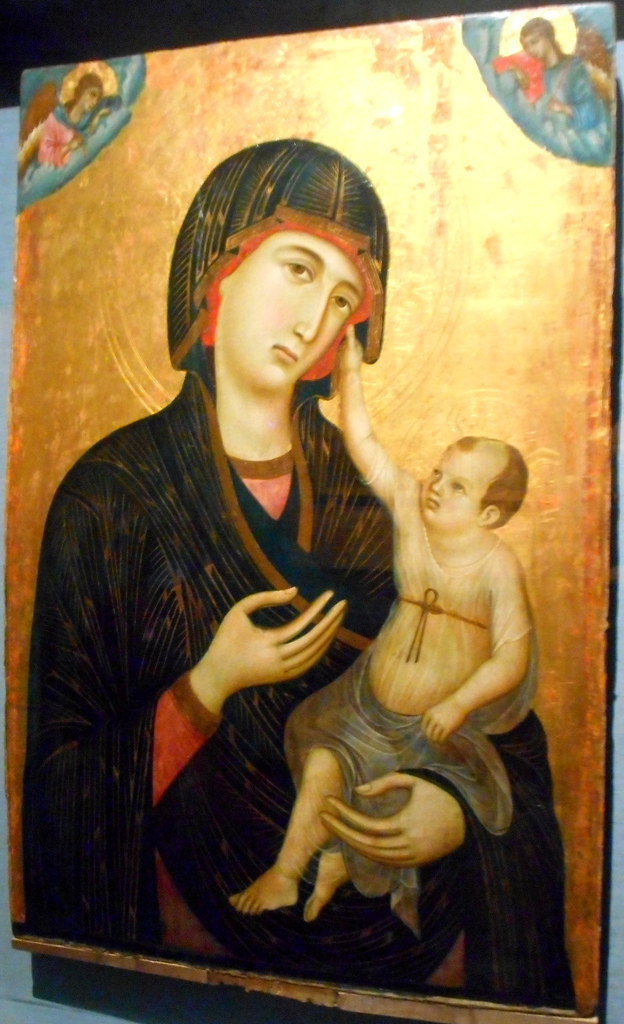Ecclesiastical art in the Middle Ages
Leaving primitive times, the period of the Middle Ages is one of enormous artistic importance, and it is an era in which the influence of the Church is practically paramount.
To this period there does not belong any very long series of artistic objects relating exclusively to domestic life. There were, of course, articles of domestic interest marked by artistic skill, there were objects of personal decoration and appliances for use in the home; but the choicest talent and the efforts of the most supreme genius were almost invariably given to the work of the Church, and even where the commissions related to domestic ornamentation, there was generally a religious element in the decorations and the use of religious symbolisms.
Enamels
To this period belong the magnificent work in enamels executed for church work. There are the tall pricket candlesticks, superb chasses and reliquaries, altar-crosses, crosiers, shrines, censers and incense boats, crucifixes, morses for copes and medallions for sacred vessels, triptychs and polyptychs for use on the altar, plaques for book-covers, especially for the adornment of the Book of the Gospels, cruets, basins, chalices, and book-binding in metal encrusted with jewels.
The very first British enamels were merely a kind of coarse decoration, applied to the adornment of shields and helmets, but later on to cups, vases, and drinking-vessels, but, when mention is made of the Ardagh Chalice and the Alfred Jewel, it will be realized that a period in enamel work has been reached when the Church laid its hand upon the craft. Concerning the use of the Alfred Jewel, it may be broadly stated that the most probable theory is that it was the ornament applied to the head of an ivory pointer used by the deacon when reading the Book of the Gospels, and that therefore this exquisite object now in the Ashmolean Museum at Oxford is one of the earliest examples of ecclesiastical enamel work. The Ardagh Chalice, of translucent enamels on silver and gold, is only one of a group of Irish shrines, reliquaries, missal-covers, crosiers, and crosses, similarly decorated, and it would appear likely that these Irish or Celtic enamels, of which half a dozen adorn the altar of Sant' Ambrogio in Milan, are perhaps among the earliest existing examples of the art in connexion with ecclesiastical possessions.

In the first part of the eleventh century, Byzantium appears to have been the headquarters of the work of ecclesiastical enameling, and the pectoral cross in the South Kensington Museum maybe taken as an example of early Byzantine work. The art of the enameller was also in existence in Germany at an early date, and here also was applied exclusively to ecclesiastical objects. Towards the middle of the twelfth century the workers of Limoges came into prominence, and from that time down to the end of the thirteenth Limoges was the centre of production. In Italian enameling, the wonderful translucent reliquary, dated 1338, the work of Ugolino of Siena, in which is preserved the great relic of the Holy Corporal at Orvieto, is a masterpiece of the craft. The altar-frontal at Pistoja belongs to about the same period, and a little later comes the reliquary made by the brothers Arezzo, while during the whole of the fourteenth and fifteenth centuries the enamellers were kept hard at work in Italy producing objects intended for Church work in two or three distinct processes, either that called champleve, or another method, that of floating transparent enamels, known by the name of bassetaille, or still another process called encrusting. At the end of the fifteenth century, and the beginning of the sixteenth, in the era of the Renaissance, the art left Italy, and, taking a new form, that of painted enamels, or more strictly, painting in enamels, had a recrudescence in France in the very same place, Limoges, in which the old enamels had been produced.

Embroidery
In another division of applied arts are the remarkable embroideries which adorned all the sacred vestments, representing in the most wonderful pictorial effect, groups of saints, sacred scenes, and religious symbols. On the chasubles, copes, albs, stoles, maniples, burses, veils, mitres, frontals, super-frontals, and altar-covers, palls, bags, and panels of that period, are to be seen triumphs of artistic excellence, worked with exceeding beauty, and with a glorious richness of colour, by the hands of the faithful women of the day and designed by the men of supreme genius whom the Church had attracted to her side.
Some of the very finest of this embroidery work was English, and references are found to the dignity of English embroidery before the end of the seventh century, as, St. Aldhelm Bishop of Sherborne, celebrated in verse the skilful work of the Anglo-Saxon embroideresses. Indeed, at one time, rather too much attention in the convents for women seems to have been given to this fascinating needlework, for a council held in 747 recommended that the reading of books and psalm-singing by the nuns should receive greater attention, and that not quite so many hours should be spent in needlework. As early as 855 the Anglo-Saxon King Ethelwulf when journeying to Rome took with him as presents silken vestments richly embroidered in gold, executed in his own country, and there are vestments of a stole and maniple, found in the tomb of St. Cuthbert (d. 687) which were produced under the auspices of the wife of Edward the Elder in 916 and placed in the saint's coffin. From that time down to the middle of the sixteenth century there was a constant demand for the work of the skilled embroideresses, and this section of art, so particularly suitable to ecclesiastical purposes, was one of perennial richness. It is well that some stress should be laid upon the question of embroidery, inasmuch as in the Middle Ages it was almost exclusively a branch of ecclesiastical art, and nearly everything that can be termed of importance in fine embroidery, especially in fine English embroidery previous to the fifteenth century, was executed for the Church. Enormous labour was given to the production of these beautiful vestments, and as an example it may be mentioned that a frontal presented to the Abbey of Westminster in 1271 took the whole labour of four women for three years and three-quarters. Lincoln Cathedral in the fourteenth century possessed over six hundred vestments in its sacristy, while the Abbey of Westminster had very nearly double as many, and even the English churches were far behind those of Spain in the sumptuous manner in which they were supplied with vestments.

There was therefore every possible necessity for the work, and no branch of art has a greater importance between the twelfth and the fifteenth centuries than has this one of embroidery. Fortunately, a sufficient number of the old vestments have come down to the present day to give a satisfactory idea of their importance and beauty and the records and inventories of church goods prior to the sixteenth century afford still further information concerning this branch of art.
Motivating spirit
The spirit of devotion which has ever given the instinct to decorate the house of God with the very finest works of which man is capable led to this lavish display of artistic genius in the service of the Catholic Church, but it must also be borne in mind that there were other, subordinate causes to account for the work. The Church, following its Divine Master, has always inculcated the importance of good works and it has ever encouraged the faithful to give to its service of their best. If their skill was in metal-work, in embroidery, in carving wooden figures or wonderful choir-stalls, in stained glass, in jewelry, in fresco or in mosaic such skill was to be devoted to God's service as the choicest gift the artist had to lay upon the altar symbolic of his devotion to his faith.
Even beyond that, there came the occasions in which the penance for sin took the form of the devotion of artistic gifts to the work of the Church, and the other and very numerous cases in which this artistic labour was the constant employment of those persons who had devoted their entire life to the religious career, in the various monastic houses belonging to the different orders. One further cause must not be overlooked, the fact that it was the Crown, the clergy, and the nobility who alone could command, by reason of their means, the splendid productions of the men of genius of the time, and that while the commissions given by the clergy would most certainly be for church purposes almost exclusively, those given by the Crown and the higher nobility were in almost all instances for exactly the same purposes, and this for a double reason.

First, the desire to render the home beautiful had not yet arisen to any considerable extent, and secondly, there was every wish to make the private chapel or oratory, the public church or royal sanctuary, as beautiful as possible, both to carry out the instincts of the religious feeling and please those who held control of spiritual things, as well as to heap up a reward for good deeds which would have a corresponding equivalent in the future life and might serve as retribution for the deeds of violence that formed so integral a part of the life of these centuries. The period under consideration was not so much one of portable pictures as of applied art, devoted to the interior decoration of the sacred buildings and to every object having connexion with the service of the altar.
Monastic anonymity
One section of ecclesiastical art deserving special mention concerns almost exclusively the monastic orders, namely, that of illumination and transcription. All over Europe the monks of the pre-Renaissance time were engaged in preparing the books of the day and these books were almost exclusively religious ones. The number of those concerning domestic matters, agriculture, or the classics, transcribed by these diligent students, is relatively small, but the series of religious works from their diligent pens is an exceedingly long one. Their time was fully occupied in preparing manuscripts for use within the cloisters and for the service of the altar, as well as for the great patrons of the monasteries who desired to have books of devotion for their own use, or for gifts to other sovereigns or noblemen. These manuscripts are of incomparable beauty, being transcribed with extraordinary skill upon the finest of vellum, and adorned with initial letters, calendars, and illustrations, that are triumphs of artistic skill, and marvels of ingenuity.

The Books of Hours, Missals, Breviaries, and Psalters having their origin in the monastic houses of England, France, Germany, and Italy during the Middle Ages are now among the greatest artistic treasures of the world and with regard to them there is one very striking fact which must never be overlooked. This does not relate exclusively to books of devotion, it belongs nearly as much to every work of art produced during this period, and it is the fact that these triumphs of skill are for the most part anonymous. In the period hardly any great names are recorded in connexion with such work. There is a wonderful series of artistic treasures, but signatures scarcely ever exist. Here and there the name of an enameller is known or perchance the name of the place where he worked, occasionally the name of a wood-carver or a worker in stained glass has been preserved and there are just a few cases in which the name of the zealous monk who toiled over the manuscript is known, but the instances are exceedingly few, and they occur, one might say, by accident rather than by intention.
With respect to illuminations in books of devotion, one monk took up the task where the other had left it. Death caused no cessation of the self-imposed labour. The orders could never die, and as in the present day great literary works are undertaken by the leading orders, in the full knowledge that to carry them out will extend far beyond the life of the writer who begins the undertaking, but that his successor will be equally able to continue the task. So in the earlier days the monks laboured in their cloisters, each at his own work; each generation of monks in the footsteps of the former, hiding the individual identity in the name of the order and content, as the work was done for the greater glory of God, that while the work should remain, the monks themselves should be forgotten.

Few things are more striking in considering this period than the singleness of aim and devotion to duty which characterized these artists and led them to have no desire to perpetuate their own names, but simply to carry out to the best of their abilities, the allotted task for the glory of God and His Church. Partly, of course, the reason was that the dignity of personal labour was not fully realized, but the reason for this anonymity lies mainly in the facts already stated, that the work was religious work that the aim was a religious aim, and that the identity of the person did not matter, so long as the Church was properly served by her faithful.
Desire for perfection
There is one other aspect of the artistic work of the pre-Renaissance time to be alluded to. It is by no means confined to the pre-Renaissance period, but extends through the succeeding centuries, and it should extend to all the artistic labour of the present day, but it is more especially a feature of the period under discussion. It is that determination which is nearer satisfied with the work which has been done, but which is always straining forward for finer and better work. It is that element of untiring energy and ever-quickening desire for perfection which has always characterized the greatest art-workers of the world, and it finds its earliest and perhaps its strongest development in this period.
Early Italian painters
The early Italian painters fall into two groups: the first, that which may be called the group of the miniaturists or illuminators, as, for example, Enrico, Berlinghieri, and Oderico; the second, the very primitive painters, such as, Margaritone, Spinello, Uccello, Cimabue, Duccio, Memmi, Lorenzetti, and the various early masters of the schools of Siena, Padua, and Verona. The predecessors of these artists for the most part, worked without any reference to nature, under Byzantine influence, copying slavishly the methods fixed by the Greek Church. Their pictures, whether they illustrated scenes from the Sacred Writings, the legends of the Church, or the lives of the saints, were designed and painted according to fixed rules. Their work was inferior to that of the Byzantine workers in mosaic, but followed the same conceptions of art; in every way, in attitudes, compositions, types of face, folds of drapery, and even as regards colour, it was guided by the definite rules of tradition, so that the painter was little more than a mechanic.

Still, despite what may be termed the ugliness of this particular school, there was a strong spirit of devotion exercising the minds of the artists, and they were able to put a certain amount of sympathy into their hard, angular productions, thus showing that their works were painted with religious sentiment, and with a desire to evoke that sentiment in others. Margaritone was one of the first to break through the hard crust of rules, and although his work does not show any very striking advance upon that of his predecessors, yet in his pictures and in those of the earliest painters of Siena, we begin to find the desire to paint a Mother of God bearing some living semblance to a Mother of Man. There is a struggling towards tenderness and sweetness of countenance, a desire to represent raiment gently floating in easy curves, and a greater command of sentiment, together with a simplicity in story-telling, which mark this primitive school, and prepare the way for the forerunner of natural treatment, Giotto himself.





